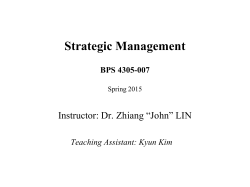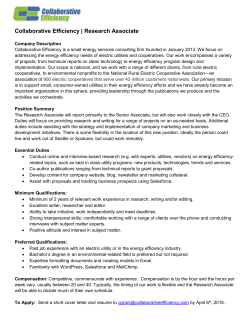
Associate Course Syllabus - Software Architecture
Associate Course Syllabus - Software Architecture Course Aims and Objectives As the capstone for the associate software architect curriculum this course provides the final elements necessary to the knowledge and practice of the profession. During the course you will explore the software engineering and application development practices that distinguish you as a software architect. The program builds on the IT environment skills and design skills learned in the foundation associate courses. After this course, you will be able to: Rise to design challenges through use of tools and methodologies. Reduce business risks associated with building technical solutions. Address stakeholder requirements and satisfy both functional and quality requirements. Refer to international standards to help structure your architect team and projects. Format and Procedures Each day the course instructor will guide students through, discussions and recommended best practice for delivery of Software architecture and value. Student’s progress through detailed definitions and ontology, instructor and student led discussions, Offline and online workshops and industry case studies based on the fictitious Tinkleman company scenarios. IMPORTANT: All courses now include the certification exams. Full membership is required to sit any certification exam. If you are not already a FULL MEMBER, please click here to register ($125). To maintain your certification CEU's must be maintained. Click here for more information on CEU requirements. Prerequisites Minimum: Knowledge of the IT Body of Knowledge (ITABoK) - Downloadable materials included in membership (separate registration is required). Business Technology Strategy pre-work materials included. Recommended: CITA-Foundation Certification Associate Course Syllabus - Software Architecture Module 1 – Software Architecture Fundamentals Lesson 1 – Roles and Teams • Workshop 1.1 – Creation of the Software Architecture Job Description Lesson 2 – Viewpoint Considerations of the Software Architect & Terminology • Workshop 1.2 – Views and Viewpoints Application Lesson 3 – Software Architecture Principles Lesson 4 – System Structures • Workshop 1.3 – Patterns and Anti-Patterns Research Assignment Module 2 - Software Construction Lesson 1 – Application Development and Visualization • Workshop 2.1 – Requirements Validation Lesson 2 – Programming Patterns • Workshop 2.2 – Selecting the Right Development Methodology Lesson 3 – Software Construction Lesson 4 – Technology Platforms Module 3 – Components, Frameworks and Tools Lesson 1 – Client Programming and User Experience (UX) • Workshop 3.1 – Selection of Infrastructure Components Lesson 2 – Client, Server and Storage Technologies • Workshop 3.2 - Modeling Lesson 3 - Workflow • Workshop 3.3 – Creation of a Generic Architecture Lesson 4 – Database Programming • Workshop 3.4 – Database Design and Considerations Module 4 – Service Network Lesson 1 – Asynchronous and Synchronous Distributed Computing Lesson 2 – SOA • Workshop 4.1 – Applying SOA Principles Lesson 3 - Messaging, XML and B2B Lesson 4 – Application and Service Management • Workshop 4.2 – Connecting the Sum of the Parts Copyright 2014 IASA. All rights reserved. The contents of this document may not be shared without prior written approval from the IASA. 2 Associate Course Syllabus - Software Architecture Module 5 – Architectural Process, Methods and Artifacts Lesson 1 – Modeling Lesson 2- Applying Design Patterns • Workshop 5.1 – Capture and Trace of Software Architecture Lesson 3 – Code Quality Analysis Lesson 4 – Design Patterns Selection and Application Module 6 – Architecture Throughout the Lifecycle Lesson 1 – Software Architecture Governance Lesson 2 – Working with other Architects • Workshop 6.1 – Application Service Transition Lesson 3 – SDLC - What it means to the Software Architect • Workshop 6.2 – Formal Release Policy Lesson 4 – Professional Growth and Mentoring Copyright 2014 IASA. All rights reserved. The contents of this document may not be shared without prior written approval from the IASA. 3
© Copyright 2025














